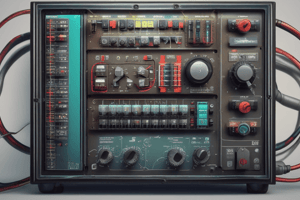Podcast
Questions and Answers
What is the formula to calculate power in an electrical circuit?
What is the formula to calculate power in an electrical circuit?
- P = V + I
- P = I/R
- P = IV (correct)
- P = V/R
How does resistance vary based on a material's conductivity?
How does resistance vary based on a material's conductivity?
- Resistance decreases with increasing conductivity. (correct)
- Resistance increases with increasing conductivity.
- Resistance remains constant regardless of material conductivity.
- Resistance and conductivity are directly proportional.
In an electrical circuit, what does high current levels usually indicate?
In an electrical circuit, what does high current levels usually indicate?
- High energy consumption (correct)
- Voltage drop issues
- Reduced resistance
- Low energy consumption
Which parameter determines the strength of electricity flowing within a wire?
Which parameter determines the strength of electricity flowing within a wire?
What units are used to express resistance values?
What units are used to express resistance values?
How does power relate to the rate at which electrical work gets done?
How does power relate to the rate at which electrical work gets done?
What does voltage represent in an electric circuit?
What does voltage represent in an electric circuit?
How is current defined in an electric conductor?
How is current defined in an electric conductor?
Which instrument is commonly used to measure voltage in electrical systems?
Which instrument is commonly used to measure voltage in electrical systems?
What does a higher voltage indicate in terms of energy per charged particle?
What does a higher voltage indicate in terms of energy per charged particle?
In terms of resistance, how does current flow through a conductor get affected?
In terms of resistance, how does current flow through a conductor get affected?
What does the term 'power' in electricity refer to?
What does the term 'power' in electricity refer to?
Flashcards are hidden until you start studying
Study Notes
Electrical Measurements: Understanding Voltage, Current, Resistance, and Power
Electricity is all around us – from our homes' light bulbs to powerful industrial machinery. To ensure safety, efficiency, and optimal performance of electrical systems, it's crucial to understand how we measure their fundamental quantities. In this exploration, let's delve into voltage, current, resistance, and power measurements—the building blocks of understanding electricity.
Voltage Measurement
Electrical potential difference, more commonly known as voltage (V) or electromotive force, represents the energy per unit charge between two points within an electric circuit. This property quantifies the work needed to move one coulomb of electric charges through a closed loop from one point to another against the direction of conventional current flow. We typically measure voltage using voltmeters.
Volts can also indicate the pressure pushing electric charges along wires and other conductive materials, much like water pressure moves liquid through pipes. A higher voltage means more energy per charged particle, leading to increased speed and kinetic energy transfer.
Current Measurement
Current (I) refers to the rate at which electric charges pass through a given cross sectional area (usually expressed in amperes) within an electric conductor. This property describes the amount of charge moving past a specific location per unit time. Amps are calculated by dividing the total quantity of electric charges (in coulombs) passing a point over the elapsed time (in seconds).
Much like a river's flow, current determines the strength of the electricity flowing within a wire. High current levels often signify high energy consumption, potentially creating heat if uncontrolled. Therefore, carefully managing current distribution helps improve system reliability and prevent accidents caused by overheating circuits.
Resistance Measurement
Resistance (R) measures a material's opposition to electrical current. It's inversely proportional to an object's conductivity; metals with fewer impurities tend to have lower resistances, while insulators offer vastly greater resistance. Ohm's Law states that the relationship among voltage, current, and resistance follows a linear equation: ( V = I \times R ).
Ohms are used to express resistance values, and they vary widely depending upon the materials involved and the shape of the conducting pathway. Knowledge of resistance provides valuable insights when designing and optimizing various components within electrical networks.
Power Measurement
Power (( P )) reveals how fast electrical work gets done. It calculates the amount of electrical energy transferred or transformed per unit time according to the formula (P=IV). Watts are the standard units measuring power, generally considered the most critical parameter in determining a device or component's capability and cost effectiveness.
Understanding power enables engineers to predict the output capacity required for different applications effectively. For instance, a larger power rating ensures a brighter lightbulb or faster charging rates.
Familiarity with these foundational concepts remains essential across diverse fields such as electronics engineering, renewable energies, power transmission, and lighting design. Proper application of these principles allows for safer, greener, and more efficient use of electricity throughout our lives.
Studying That Suits You
Use AI to generate personalized quizzes and flashcards to suit your learning preferences.





